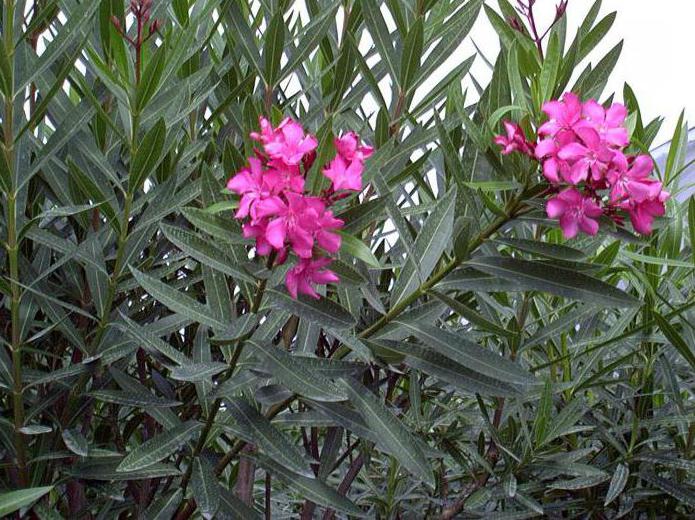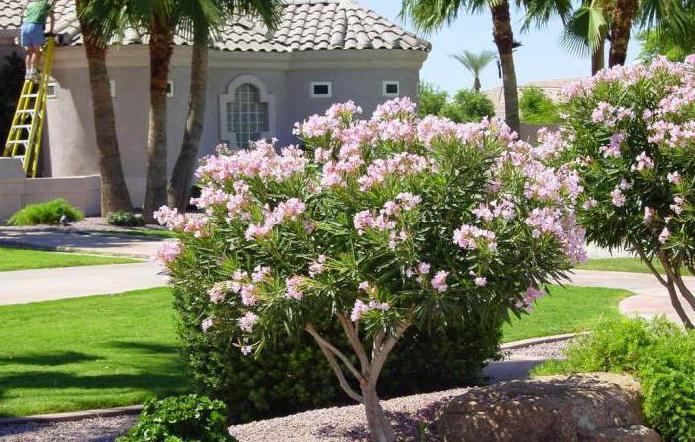
Oleander is a beautiful plant that adornsa good half of office buildings, and in residential apartments it meets regularly. It is a decorative perennial shrub that belongs to the family of kutra. Many legends and myths are associated with it, and mistresses who grow oleander in their living room, poisonous or not, sometimes do not even know this flower. But it was this property that gave rise to the legend of the soldiers who cooked their own dinner on its long leaves. Is it worth adding that in the morning none of them woke up.

This is a very attractive plant with fragrantflowers, however it is not recommended to grow it in houses. It is much better to leave the giant for office halls, where no one will come to mind to break off the twig. Even if you do not have small children and pets, the evaporation that causes a headache can be dangerous. Of course, a small plant in the hall is unlikely to harm, but if it is in a tiny bedroom that is rarely ventilated, it is quite possible that it will have a negative effect on your body.
Even the most dangerous plants can be toxicbe only separate parts. But not such an oleander. Poisonous or not, it is better not to test in practice. All parts of the plant can be poisoned. Even in the dried form they retain toxins. Leaves and stems, fragrant flowers and roots, but especially dangerous fresh and dried juice, which stands out in the notch. Getting into the eyes, it leads to blindness, and recovery is not subject to recovery. But most of all the harm will be if the juice gets into the digestive tract. Even a tiny amount leads to the fact that a person can die without quality and timely help. Such is the handsome oleander. Poisonous or not, now you can no longer doubt. And for the safety of curious kids, it's better to "evict" the plant to one of your friends.

Where did the "pink laurel" come from? This shrub with leathery leaves, brownish stems and bright colors came from Morocco. Poisonous or not oleander, most of the florists did not even know, but fell in love with the plant for the simplicity of cultivation. His homeland is the western part of China, and it is found in Portugal. Like many other African plants, it is not recommended to use it for growing in closed, small rooms, so that harmful fumes do not affect the health of the household.
In fact, this is a completely different plant, buthas similar features to the laurel. Its brown stems are covered with the same dark green leathery leaves with pointed form. In nature, it grows into two man's growth. At home, do not exceed two meters, but only if you provide good lighting, a large pot and feeding. Therefore, it is recommended to put it in spacious halls and vestibules with good lighting. A poisonous plant or not, the oleander has become so fond of flower growers that no one will refuse to refuse it.

Beautiful, fragrant corollas are collected in carpalinflorescence. They can be simple or terry. Today there are quite a lot of varieties, so you can get the appendage you enjoy with yellow or red, pink or white panicles. Of course, the most beautiful can be considered a terry oleander. Poisonous plant or not, today is already known. Toxic juice makes all its parts dangerous. Therefore, you need to take care of him very carefully. Even an experienced florist must follow certain precautions, wear gloves and a mask in any interaction with the plant.
But there are also positive aspects. In addition to the decorative function, the oleander also purifies the air very well. And this means that in the room in which he settled, there will be much less slag and toxins.

A poisonous oleander flower happens:
But that is not all. In turn, ordinary oleander has many varieties. Especially good hybrids. Their flowers reach enormous sizes, they are lush, monotonous and variegated.
The Indian oleander can not boast of sucha variety of forms and colors, but from this he does not lose his attractiveness. But it blooms from June to October with large and very fragrant flowers. They can be yellow, red, pink or white.
The pink laurel is an unpretentious plant,which is able to grow even a budding floriculturist. When choosing a room decor, it is important to know in advance whether the oleander is poisonous. If the house has cats, it is necessary to take into account their passion to taste the plants. Saving the animal in this case will be quite difficult.
That the oleander grows well and develops, it is veryneed lighting. If the pot is in the back of the room, artificial light will do. The south-eastern windows are best for accommodation. For a lush and abundant flowering it is recommended to take out a pot on the loggia in the summer. In doing so, do not forget about the protection of plants against rain and direct sunlight. The light day must last at least eight hours, otherwise the buds will not form.

Room oleander poisonous, but it does not interfereto remain his favorite plant for thousands of florists. To make him grow really handsome, you need to find the right conditions for him. The pink laurel loves moist air, stable temperature and nutritious ground. Ignore these requirements is not necessary, because otherwise the plant will not bloom. So, when leaving, the following conditions must be observed:

Do not forget that before you is not harmlesschlorophytum, and oleander. The poisonous properties of the plant should be taken into account in any interaction with it, whether it be transplanting or pruning. Gloves, a mask are obligatory, and after the end of work all tools should be rinsed, clothes washed, hands washed with soap. And do not let the children go to him.
However, the plant still has to be transplanted. To do this, you need to prepare a nutrient substrate, which can consist of garden soil, manure and peat. Young oleanders are transplanted as they grow from the pot, sometimes several times a year. In order for the plant to bloom well, it is necessary to cut all branches exactly halfway after flowering. This will make room for new growths, and the bush below does not become bare.

According to doctors, even one leaf of the plantcan lead to tragedy. In Israel, he once nearly became the cause of death of six girls. Expecting that the leaves have a narcotic effect, they chewed on a small piece. The girls were found and taken to the intensive care unit on time. They did not know that oleander is a poisonous plant. Treatment for poisoning is symptomatic, but first of all it is necessary to remove toxins from the body.
In case of ingestion of any part of the plantthere is a rapid deterioration of the condition, slowing of the heartbeat, bloody diarrhea and loss of consciousness, cessation of breathing. But the beauty of its flowers is so attractive that no one will refuse to have such a plant at home. Exception - if in one territory children, kittens or puppies live with him. They are all too curious.
Despite all its unpretentiousness, it is quite easy to destroy a flower. So let's give a few words to the most common problems that growers regularly face.
There are no problems with this even for beginners. There are three effective ways, among which you can choose one that you like more:
Whether the oleander flower is poisonous or not, but there will always bewishing to put him at home. In fact, there is nothing wrong with that. If all members of the family are adults, and the premises are quite spacious, then the oleander will be a wonderful decoration. It is necessary only to be careful when caring for the plant, its transplantation and circumcision. Then the plant will regularly delight you with beautiful flowers.
